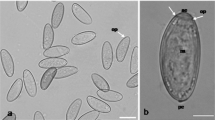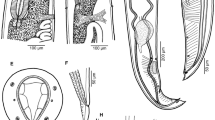Abstract
A scanning-electron microscopic (SEM) study of a clutch of eggs and juveniles of Dickdellia labioflecta on Colossendeis megalonyx megalonyx revealed that the young snails remove the upper layers of the pycnogonid cuticle, most probably by rasping. This way holes are created in the cuticle that could serve as a potential source of food for the snail. Measurements and statistics show that the holes have the same density as the cuticular glands. These glands are spread all over the pycnogonid cuticle. Additionally, they are filled with cytoplasmic material having a fine structure and cuticular surrounding that is typical for those glands. Hence, it is suggested that the snails get access to the interior of the pycnogonid through the holes and glands. Holes in the cuticle are absent under smaller Dickdellia specimens, but they are formed consecutively as they become older and grow larger. It is suggested that Dickdellia snails are ectoparasites because this would allow them to remain on pycnogonids until they exceed the initial egg volume, which would be difficult to explain without additional food uptake from the pycnogonid host.


Similar content being viewed by others
References
Dell RK (1990) Antarctic Mollusca with special reference to the fauna of the Ross Sea. Bull R Soc N Z 27:1–311
Hedgpeth JW (1964) Notes on the peculiar egg laying habit of an Antarctic prosobranch (Mollusca: Gastropoda). Veliger 7:45–46
Melzer RR, Heß M, Ludwig P, Dunkel C, Smola U (1996) Fine structure of the “slit organs” of the pycnogonid, Anoplodactylus petiolatus (Anoplodactylidae). Acta Zool (Stockholm) 77:167–171
Sirenko BI (2000) Symbiosis of an Antarctic gastropod and pantopod. Ruthenica 10:159–162
Staples DA, Watson JE (1987) Associations between pycnogonids and hydroids. In: Bouillon J, Boero F, Cicogna F, Cornelius PFS (eds) Modern trends in the systematics, ecology and evolution of hydroids and hydromedusae. Oxford University Press, Oxford, pp 215–226
Warén A, Hain S (1996) Description of Zerotulidae fam. nov. (Littorinoidea), with comments on an Antarctic littorinid gastropod. Veliger 39:277–334
Acknowledgments
Dr. Michael Schrödl (Zoologische Staatssammlung München, Germany), the sorting teams, and the crew of RV “Polarstern” are warmly thanked for their professional work. Maria Montoya (Munich) kindly determined the Colossendeis pycnogonid. Special thanks go to Nicolas Straube (Munich) for giving us help with the statistics and Stefan Schmidt for improving the English. This is ANDEEP contribution No. 56.
Author information
Authors and Affiliations
Corresponding author
Rights and permissions
About this article
Cite this article
Lehmann, T., Gailer, J.P., Melzer, R.R. et al. A scanning-electron microscopic study of Dickdellia labioflecta (Dell, 1990) (Gastropoda, Littorinoidea) on Colossendeis megalonyx megalonyx Fry and Hedgpeth, 1969 (Pycnogonida, Colossendeidae): a test for ectoparasitism. Polar Biol 30, 243–248 (2007). https://doi.org/10.1007/s00300-006-0178-6
Received:
Revised:
Accepted:
Published:
Issue Date:
DOI: https://doi.org/10.1007/s00300-006-0178-6




